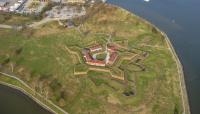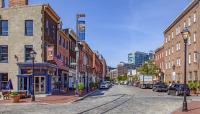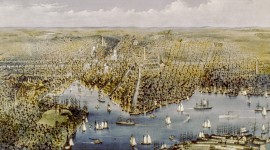Established by Congress in 2009, the Baltimore National Heritage Area encompasses approximately 22 square miles of the city that includes six noncontiguous parcels, with the largest extending north from the Patapsco River (Middle Branch, Inner and Northwest Harbors), tracing Gwynns and Jones Falls.
Originally known as Baltimore Town (established in 1730) and sited on the northern banks of the Patapsco River’s inner basin, the colonial village expanded to neighboring Jones Town and Fells Point, which were annexed in 1745 and 1773. At the dawn of the nineteenth century, the city’s economy shifted towards manufacturing and in 1812 surveyor Thomas Poppleton was engaged to map the city and plan its future development. The city became substantially fortified during this period and Fort McHenry famously withstood an attack by the British during the Battle of Baltimore in 1814 (part of the War of 1812).
Following the incorporation of the Baltimore and Ohio Railroad in 1827, the city’s railway industry expanded, and communities of laborers formed thriving neighborhoods around industrial centers. Prior to the Civil War, Baltimore’s African American population ranked among the largest in the nation and following the war, formerly enslaved people from Maryland and the South relocated to the city. As a major point of entry to the United States Baltimore attracted large numbers of immigrants during the nineteenth and early twentieth centuries, contributing to Heritage Area’s diverse character.
This significant landscape palimpsest of myriad land uses, cultural lifeways and diverse built and natural landscape features are on full display in this extraordinary urban concentration of historic, cultural, and natural resources. It includes national park units, scenic byways, dozens of sites listed in the National Register of Historic Places and fifteen National Historic Landmarks, which collectively played a significant role during the Revolutionary War, helped to forge the nation’s identity, and propelled the city to emerge as a center of commerce and culture.


















